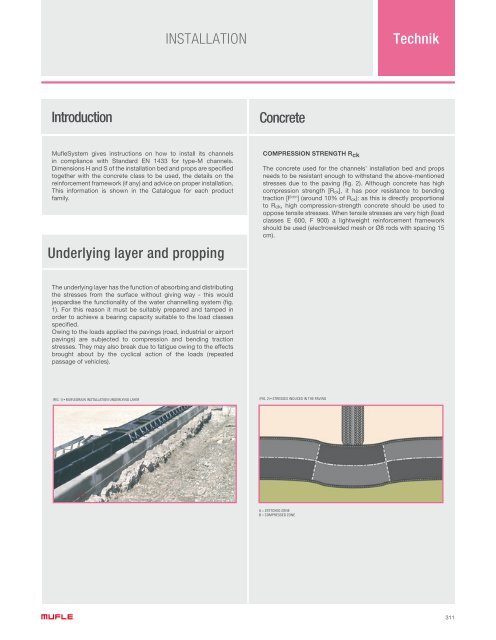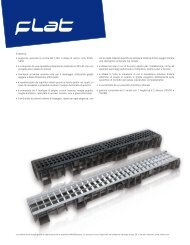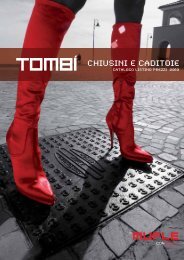MUFLEDRAIN TECHNICAL MANUAL - MUFLE.com
MUFLEDRAIN TECHNICAL MANUAL - MUFLE.com
MUFLEDRAIN TECHNICAL MANUAL - MUFLE.com
Create successful ePaper yourself
Turn your PDF publications into a flip-book with our unique Google optimized e-Paper software.
Introduction<br />
INSTALLATION<br />
Mufl eSystem gives instructions on how to install its channels<br />
in <strong>com</strong>pliance with Standard EN 1433 for type-M channels.<br />
Dimensions H and S of the installation bed and props are specifi ed<br />
together with the concrete class to be used, the details on the<br />
reinforcement framework (if any) and advice on proper installation.<br />
This information is shown in the Catalogue for each product<br />
family.<br />
Underlying layer and propping<br />
The underlying layer has the function of absorbing and distributing<br />
the stresses from the surface without giving way - this would<br />
jeopardise the functionality of the water channelling system (fi g.<br />
1). For this reason it must be suitably prepared and tamped in<br />
order to achieve a bearing capacity suitable to the Ioad classes<br />
specifi ed.<br />
Owing to the loads applied the pavings (road, industrial or airport<br />
pavings) are subjected to <strong>com</strong>pression and bending traction<br />
stresses. They may also break due to fatigue owing to the effects<br />
brought about by the cyclical action of the loads (repeated<br />
passage of vehicles).<br />
(FIG. 1) • <strong><strong>MUFLE</strong>DRAIN</strong> INSTALLATION UNDERLYING LAYER<br />
Concrete<br />
COMPRESSION STRENGTH Rck<br />
Technik<br />
The concrete used for the channels’ installation bed and props<br />
needs to be resistant enough to withstand the above-mentioned<br />
stresses due to the paving (fi g. 2). Although concrete has high<br />
<strong>com</strong>pression strength [Rck], it has poor resistance to bending<br />
traction [F cfm ] (around 10% of Rck): as this is directly proportional<br />
to Rck, high <strong>com</strong>pression-strength concrete should be used to<br />
oppose tensile stresses. When tensile stresses are very high (load<br />
classes E 600, F 900) a lightweight reinforcement framework<br />
should be used (electrowelded mesh or Ø8 rods with spacing 15<br />
cm).<br />
(FIG. 2) • STRESSES INDUCED IN THE PAVING<br />
A = STETCHED ZONE<br />
B = COMPRESSED ZONE<br />
311





